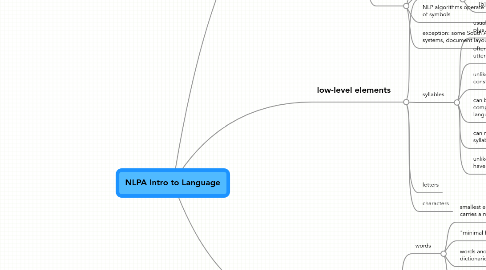
1. high level elements
1.1. words
1.1.1. smallest element of natural language that carries a meaning when uttered in isolation
1.1.2. "minimal free form" (Bloomfield)
1.1.3. words and their properties are compiled into dictionaries or lexica
1.1.4. word structure and relationship is governed by morphology
1.2. sentences
1.2.1. composed of phrases
1.2.2. usually contain a verb (in some languages, implied)
1.2.3. represent: statements, questions, commands
1.2.4. a grammatical unit
1.2.5. sentence structure is governed by grammar
2. low-level elements
2.1. phonemes
2.1.1. "The smallest segmental unit of sound to form meaningful contrasts between utterances."
2.1.2. [b] [a] etc.
2.2. syllables
2.2.1. usually defined in terms of a vowel nucleus plus extra consonants
2.2.2. often defined as the smallest actual speech utterance that cannot be "interrupted"
2.2.3. unlike phonemes, there are few constraints on combining syllables
2.2.4. can be defined statistically in terms of a compact description of the constituents of language
2.2.5. can mostly be combined freely with other syllables
2.2.6. unlike words, syllables do not necessarily have any meaning
2.3. letters
2.4. characters
3. definition
3.1. communication
3.1.1. language allows us to communicate meaning
3.1.2. describe a scene
3.1.3. describe past or future actions
3.1.4. interact socially
3.1.5. exceptions: occasionally, language is used just for its sound or decorative effect
3.2. symbolic
3.2.1. language is composed of elements that represent real-world objects and actions
3.2.2. the physical structure of the individual elements (letters, words, etc.) can be completely arbitrary and unrelated to the object it represents
3.2.3. symbols are discrete rather than continuous
3.2.4. "categorical perception" of phonemes
3.2.5. exceptions: stress and prosody in spoken language may be continuous to some degree
3.3. linear
3.3.1. language is mostly linear = 1-dimensional
3.3.2. that's a consequence of the fact that the primary source of language is human verbal communication
3.3.3. NLP algorithms operate on 1D sequences of symbols
3.3.4. exception: some South American writing systems, document layout, sign language
